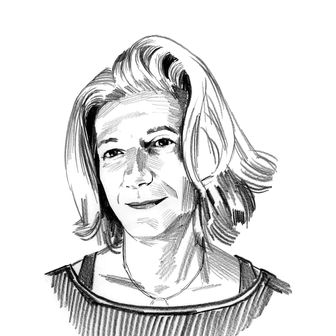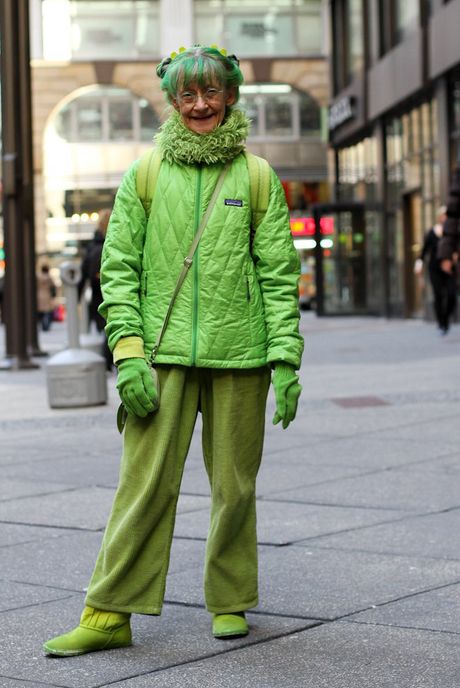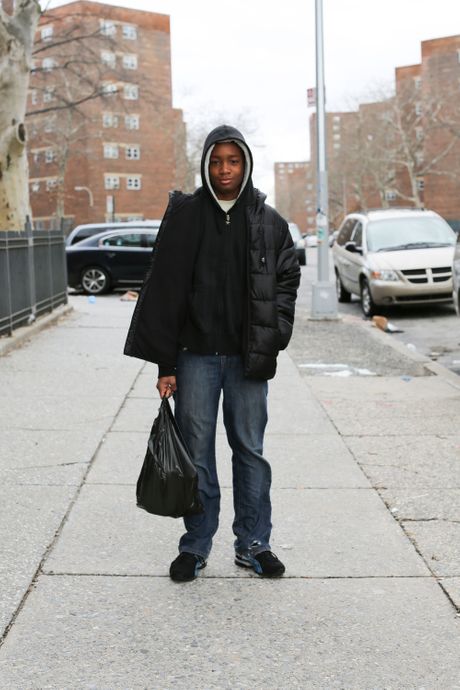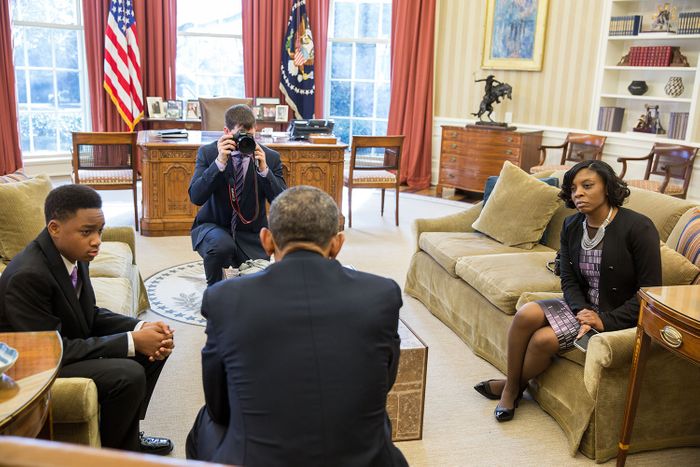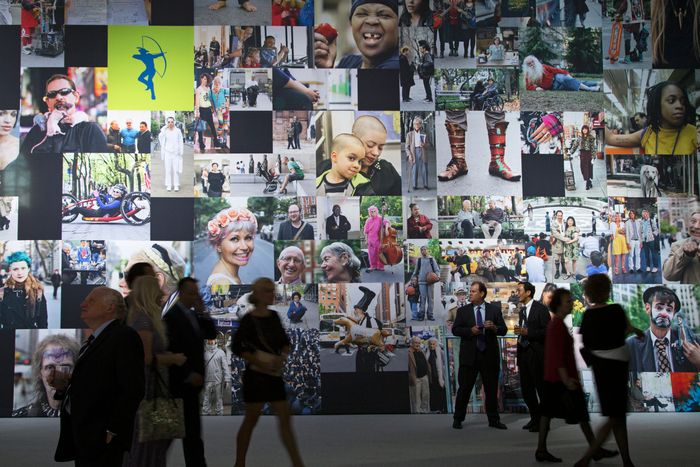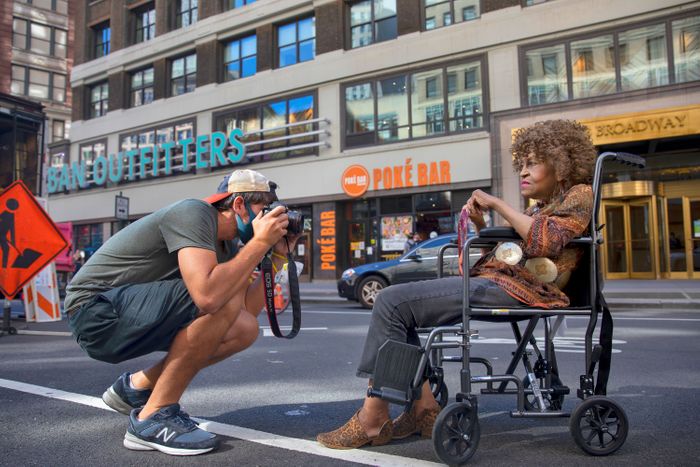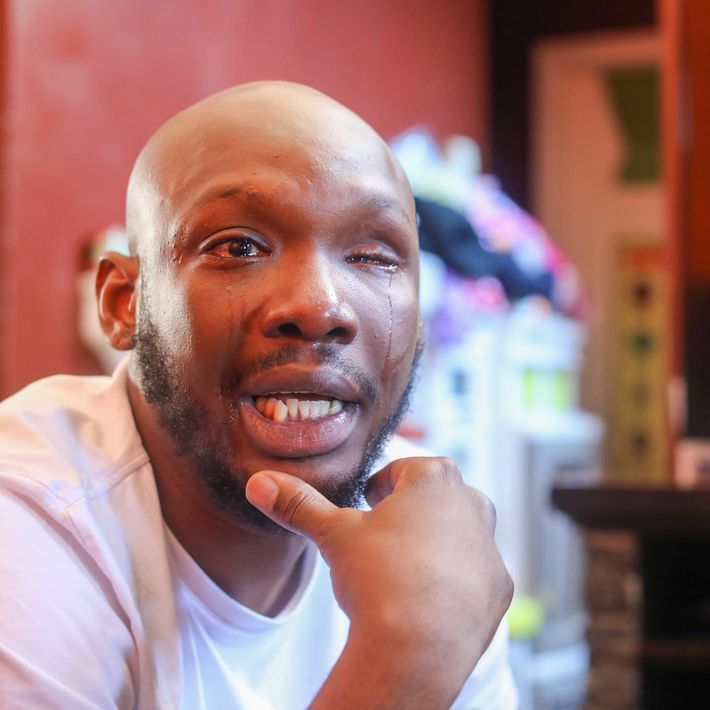
This article was featured in One Great Story, New York’s reading recommendation newsletter. Sign up here to get it nightly.
Brandon Stanton was seated on a metal folding chair in the cavernous basement of an East Harlem café. He leaned forward and jabbed at the air with long, pale fingers. “I love the idea of juice! Juice, juice, juice!” he said. “I’m excited!”
It was a December afternoon, and across the small table sat the Diallo brothers, Rahim and Mohammed, their own excitement tempered with apprehension. The Diallos, who emigrated from Guinea to the U.S. as teenagers and put themselves through college while working in restaurants and driving cabs, are the owners of the Ginjan Café, a cozy spot across from the 125th Street Metro-North station that has struggled since the commuter hordes began mostly staying home. Stanton is the creator of Humans of New York, the popular publication that has given him more wealth, freedom, and influence than he, a man whose dreams have always been outsize, ever imagined. What started in 2010 as a quirky street-photography project has morphed into an uplifting social-media empire with nearly 30 million followers on Facebook and Instagram combined who visit to affirm, relate to, and weep for the ordinary people on display. Now Stanton was planning to feature the Diallos on his blog, and all three men were hoping that the publication would result in a bonanza of sales of the Diallos’ specialty ginger juice, Ginjan.
Since the pandemic, Stanton has been steering HONY in new directions. He still takes photos of regular people, and he still grills them about their struggles and achievements and edits their responses into first-person narratives that he posts, with their portraits, on social media. But now many HONY stories include an ask. Through GoFundMe campaigns attached to certain posts, Stanton has raised nearly $8 million over the past 18 months for, among others, a retired burlesque dancer ($2.7 million), the immigrant owners of an organic bakery with a chronically ill child ($1.2 million), a man blinded by a screwdriver in a subway attack ($677,000), and a woman undergoing breast-cancer treatment who was behind on her rent ($498,000). When his protagonists own small businesses, as the Diallos do, Stanton directs the HONY throngs to their shopping pages, creating boomlets in sneaker sales ($2.7 million for the shoe company Atoms, whose Pakistani co-founder defied her parents and delayed marriage to start a business) or homemade soda-bread scones (more than $1 million for Mary O’Halloran, an East Village pub owner who was homeschooling six children while her husband worked as a longshoreman on the coast of Alaska).
His new objective is to bestow upon his subjects sufficient funds to obtain what he calls “escape velocity,” an astronomy term that he has adapted to mean “liberation from the gravity of their own circumstances.” In other words, Stanton has transformed his storytelling project into something that is part grant-giving operation, part one-man venture-capital firm, and part lottery. “I’m viewing myself very temporarily as a partner in the business,” Stanton told the Diallos as he asked them about their manufacturing and distribution plans. Ginjan — a cold-pressed elixir of ginger, pineapple, vanilla, lemon, and anise — is inspired by the beverage the brothers drank as children. A rush in sales would not only support the café long term, it would ease their expansion into Brooklyn and help them realize their ambition: for Ginjan to become a recognized brand of African beverages and food products nationwide.
Stanton avoids forecasting sales; he knows that internet virality is an elusive mark. Nevertheless, he does what he can to design success, and at the moment, he had concerns about the price of the juice: $60 for a 12-pack of an unfamiliar beverage is steep, even in service of a worthy cause. In Stanton’s view, the Diallos ought to smooth the way, perhaps by reducing the price of the juice with a coupon code. “I’m shocked at how much people love coupons,” he said. The brothers, tuned in to his troubleshooting, responded and took notes, glancing at each other to gauge accord. Stanton continued, “People are going to love these ginger drinks, but more, they will want to help these two brothers who are doing something beautiful in their lives. They want to be part of your story.” Rahim handed his laptop across the table, and upon inspection of the Ginjan Café landing page, Stanton spied something marvelous: In addition to the juice, the Diallos listed coffee beans at $15 a pound. This, as Stanton saw it, would offer a more affordable way to express support.
“You guys sell coffee, too? Oh, we’re going to do so good! I want juice and coffee to have equal prominence. I’m excited,” he said.
“We still want to push the juice,” Mohammed said cautiously. They were about to clinch a deal with a new manufacturer capable of producing 100,000 bottles of juice a day.
“Yeah, it’s going to be all about the juice,” Stanton agreed, unfazed. “But we want to sell coffee, too.”
In early 2020, as the pandemic threatened to engulf New York City, Stanton moved from his Chelsea duplex to the Atlanta suburbs, where he grew up, with his wife, Erin, and their daughter, who was about to turn 2. (A second daughter was born this past January.) I flew to Atlanta a week before our trip to the Ginjan Café; Stanton met me at the front door of his new house wearing expensive sweatpants in a herringbone pattern — his everyday pants; he has multiple pairs — and a baseball cap that he pushed around on his head as he spoke. At 38, he has a ginger’s complexion, a full head of brown hair, and bronze-tinted eyes. The family’s new rescue dog, Tabby, rested on a barley-colored sectional couch. Stanton’s welcome had a defensive edge. “I know what you’re going to say,” he said later. “You’re going to say the founder of Humans of New York lives in Georgia.”
The pandemic and the relocation gave Stanton his first chance in a decade to reflect on the purpose of his life, which had been conjoined with the ascent of Humans of New York since he was 26 years old. First it was nothing: just a harebrained idea that drew the derision and concern of family and friends. Then, two years later, it became the biggest thing on the internet. “There was a period when every single post on Facebook had over a million likes,” he said. “If every day you write something and millions of people receive it immediately, it’s a hell of a drug.” In 2013, Stanton’s first book, Humans of New York, stayed on the New York Times best-seller list for more than seven months; the year after, the U.N. sent him on a multicountry tour to advance the Millennium Development Goals. In 2015, he interviewed Barack Obama in the Oval Office and featured him on HONY, and his second book landed on the Times best-seller list at No. 1. In 2017, Facebook released Humans of New York as a docuseries, and the first episode racked up 9.7 million views.
At its apex, Stanton’s success felt to him both hard-won and ridiculous. “Do you watch Succession?” he asked me. A recent episode of the television show, in which the guests of a 40th-birthday party enter a humongous clublike space through a tunnel constructed to resemble a vagina, reminded him of the time, back in 2015, when Humans of New York had been the theme of the annual gala of the Robin Hood Foundation, a large anti-poverty charity in New York City. To enter the main hall, guests walked through the lens of a wall-size camera. When they arrived, they found themselves surrounded by floor-to-ceiling collages of Stanton’s portraits, which served as wallpaper, columns, and centerpieces. The subjects — an Orthodox Jew wearing a bike-messenger bag, a Black teenager wearing a light-skin-tone bandage on his cheek, an Asian toddler in a fedora — seemed to mingle with the A-list celebrities in attendance, among them Katie Couric, Matt Lauer, Oprah Winfrey, Andrew Cuomo, and Morgan Freeman. Paul McCartney headlined the event, which raised more than $100 million. He played “I’ll Follow the Sun.”
But the internet evolves, and just a few years after the gala, many people started to think about HONY in the past tense — as a relic of the feel-good Obama era that upheld “universality” over difference. By 2018, Stanton still had tens of millions of followers, but his posts weren’t showing up in everyone’s feeds anymore. “It has to do with algorithms,” he said. Also, he admitted, “I’d lost the novelty.” This was largely out of his control. He had started HONY the year Instagram launched and Apple introduced its first phone with a front-facing camera. In the intervening years, though, social media had learned HONY’s moves. Across the internet, authentic stories of real people had become commodities, used to correct the record, boost a brand, or persuade followers to adopt a cause. GoFundMe appeals, political solicitations, influencer testimonials, and Verizon ads all began to look and sound the same — and a lot like Humans of New York. In the past year, Stanton had received both an award for his efforts in humanitarian service and an award from the advertising industry for his storytelling. He seemed embarrassed by both.
I wasn’t at Stanton’s house for 20 minutes before he started to cry. When he interviews people, he always starts with “What is your biggest struggle right now?” And when I posed that question to him, he began by describing how difficult it was to attain his success and how single-minded he had been in the pursuit of it. When he was 19, he went through a phase of being very religious. He was Christian, not in the churchgoing way but in a “God is love” kind of way, and he insisted to people he would write a great novel that would contain the wisdom of the ages and share it with the world. The intensity of his faith eventually dimmed, but today, as he sat in his living room contemplating the unlikely string of events that had made his achievement possible, he could only regard it as a miracle. Out of nothing, he had made something massive that held meaning for millions. “Just through working hard, I managed to arrive in a position where I had the power to help more people and do more good than I could have possibly imagined,” he said.
Stanton was sobbing now, so openly that he had to wipe his eyes with first his sleeve and then the hem of his shirt. Tabby had her head in his lap, and he was massaging her ruff in big, clawing motions. “What happened to me was just so incredible. Like, it worked. This crazy thing worked. And it got so big,” he said. In the pandemic, he found himself hungering to find a new mission for Humans of New York, one that might provide him with a deeper, more lasting fulfillment. “I’m asking myself — maybe Facebook and Instagram disappear. I’m going to have to build my work somewhere else, so maybe I’d like to have more name recognition,” he said. In year one of the pandemic, he put “Created by Brandon Stanton” on the HONY Instagram page for the first time. He began writing much longer stories — often taking up a dozen or more posts on Instagram — that he hopes have the lasting power of literature.
Then, one night in late 2020, while on vacation in the Smoky Mountains, Stanton was struck by an agonizing pain in his left arm, like nothing he’d ever felt before. For a few weeks, the doctors suspected Stanton might have a life-threatening autoimmune disease, and as he contemplated the possibility of his death, Stanton’s priorities became clear. He would concentrate on using HONY to materially and spiritually help others. He relinquished the writing credit on a TV series he’d fought hard for. Stanton was ultimately diagnosed with an autoimmune disease that wasn’t terminal, but he had already made up his mind: “I’m focusing my lens on people who are modeling energy and behavior that is moving the world in the right direction. I’m raising money. I’m trying to help where I can.”
For a person who mines the biographies of others for significant buried details, Stanton is notably ineloquent about his own childhood. It was “good,” he told me. “It was nuclear. And there was structure.” His parents divorced when he was a baby — his father struggled with drug addiction — and his mother soon remarried. Stanton’s stepfather, whom he calls Dad, was a stable presence in his life. (As an adult, Stanton reconciled with his biological father, who had gotten clean.)
He attended a local private high school. There, Adam Schaefer, who remains a close friend, remembers that Stanton wasn’t a great athlete but was an eager one: On the football field, “he hit people hard.” In his sophomore year, a legendary ballplayer named Andrew Kown transferred to their school, and shortly after his arrival, Stanton created the AKFC: the Andrew Kown Fan Club. It began as a joke, but some two-thirds of the school joined, and Stanton built a website, collected dues, and even organized a parade — a caravan of a hundred or more cars that blocked traffic for a mile. Schaefer recalls that Stanton was smart, but it was not his intelligence that set him apart. It was his confidence, his ability to double down on whatever idea he had, tuning out doubters in the face of long odds. Schaefer called this his “irrational self-belief: I will figure this out. It will be huge. It will be so huge it will blow your minds.”
Stanton flunked out of the University of Georgia his freshman year. “He was kind of a stoner,” remembers Sam Ward, another high-school friend. Stanton’s parents wouldn’t let him come home, and he became aimless, residing for a time in his grandparents’ basement. He scraped together cash by writing papers for some of his high-school friends for $20 a page. It was a rebellion and, in a way, inevitable. Convinced of his own inner greatness, he found the conventional path — distribution requirements, homework, a formal profession — excruciating. But at the same time, he hated being what he calls “the fuckup.” “That’s when I picked up the New Testament,” he said. “And I just flipped from There is no God and it doesn’t matter to There is a God and it’s all that matters.” Schaefer’s father got him a job at the smoothie-and-wraps shop he owned, and otherwise Stanton hung out in a Borders bookstore and went for walks in the woods, talking with Ward about how to accomplish something equal to the scope of his vision.
When Stanton speaks about this era of his life, as he does frequently to podcasters and in lectures on college campuses, he does not speculate on its psychological causes. He emphasizes instead the route he took out of his wilderness. He picked up Walter Isaacson’s biography of Benjamin Franklin, in which he came across Franklin’s aphorism “Genius without education is like silver in the mine.” He established a routine to which he says he adhered fanatically. Each day, without exception, he jogged for 30 minutes and he read 100 pages of nonfiction, primarily biographies of Powerful Men: mostly American sages and statesmen but also Hitler and Stalin. (The LBJ series was a particular favorite: “I’ve never seen him fanboy except to meet Robert Caro,” said Michael Crommett, a cinematographer who has worked with Stanton closely.)
During this period, Stanton came to believe that through hard work, discipline, and commitment to a goal, people make their own fate — a view that seemed even more undeniable when it proved true in his case. He reenrolled at the University of Georgia, and upon graduation, he got a job as a bond trader at a firm in Chicago, which made his parents proud. Stanton had a penchant for high-risk trades, so he started losing money when the markets cooled. Looking for a distraction from work, he bought a good camera with $3,300 he won in a football betting pool. He had never taken a photography class, but when he saw he was about to be fired, he decided that was what he wanted to do with his life.
The idea, originally, was to photograph 10,000 New Yorkers and plot them on a map. Stanton had moved to the city in the fall of 2010 and was just walking around taking pictures of strangers. He began posting four images a day to Facebook, and he called his project Humans of New York. He was not, he admits, a good photographer, but in a way, that was his edge: He was every dude, awestruck at the exhibition of humanity on display in the city. And like an enthusiastic yearbook editor, Stanton wrote the captions, which could take the form of tone-deaf observations: “That mustache is so sikh,” he wrote beneath a portrait of a man in a saffron turban with extravagant facial hair.
On December 11, 2011, Stanton was in bed with the avian flu. He couldn’t take pictures, but he felt pressure to post, so he scrolled through his camera to see what he had. There was one picture he thought was okay of an older woman dressed entirely in lime green, from her jacket and pants to her gloves and shoes. She had green hair and carried a little green purse across her chest. She wore a small conspiratorial smile. Instead of writing a caption, he used a snippet from the conversation they’d had while he was setting up:
“So do you do a different color every day?”
“No, I used to go through different stages. But then I found I was happiest when I was green, so I’ve been green for 15 years.”
The blog was still tiny, but the likes poured in, and Stanton understood he had stumbled onto something. New Yorkers exist in crushing proximity to strangers: First dates, tantrums, cigarette breaks — all these ordinary events are conducted in plain view, so curiosity about others’ lives, a kind of incidental voyeurism, is the New Yorker’s constant mind-set. The woman’s quote, guileless, seemed like an open invitation into the world of someone you didn’t happen to know but under the right circumstances might. As the project grew, his audience expanded far beyond the five boroughs. For Stanton, the interviews — the encounters with random passersby, the intense exchanges amid foot traffic and horn blasts — became a sacred space. “There’s something pure about it,” he said. “Even with all my weaknesses. Because it’s bigger than me.” And by telling the stories, if he does his job right, “millions of people feel it. And millions will be changed by it in the same way that I was changed by it on the street.”
The stories, presented in his subjects’ own words, gradually grew from a few sentences to paragraphs and occasionally pages. They were about everything: bullying, divorce, mental illness, sex, body image. But Stanton said that, as an artist, he found the best stories were those in which a protagonist overcomes hardship and is redeemed. On HONY, many of his posts began to follow a classic arc in which a hero faces an obstacle, comes to self-understanding, and reaches a resolution — an antidote to the shallow fragments that populated the internet at the time.
In 2015, Stanton posted the story of a middle-schooler in Brownsville: a Black boy in a hoodie smiling ruefully against a backdrop of housing projects. In the caption, the boy admitted he and his friends sometimes got in trouble but his principal, Ms. Lopez, gave him a reason to work hard and be proud of himself. “She doesn’t suspend us,” he said in the post. “She calls us into her office and explains how society was built down around us. And she tells us that each time somebody fails out of school, a new jail cell gets built.” The post earned over a million likes, the comments a cheering section bigger than the crowd at Madison Square Garden — more than 20,000 people weeping for and encouraging his perseverance. In the comments, followers begged Stanton to interview Ms. Lopez, and he did, photographing her at her paper-strewn desk. “I want my scholars to know that even if they live in a housing project, they are part of a royal lineage going back to great African kings and queens,” the caption read. “Put her in a bottle and spray her around!” wrote a reader.
The more stories of uplift he posted, the more people craved them. His most devoted followers, he said, who showed up for the emotional journey every time, were educated women — “because women care about people more than men. It’s the old adage ‘Men like things, women like people.’ Look, any time you can fit a life philosophy onto a bumper sticker, it doesn’t hold up in real life, but there’s a little truth to everything,” he said. “Humans of New York has self-selected for an audience that cares about people. I joke, but it’s no hyperbole: I think it’s the nicest 20 million people on the internet.”
In September 2020, shortly before the onset of his illness, Stanton published the longest story he’d written. Tanqueray was a striptease artist in the 1970s, and he had written a post about her the previous year that garnered nearly a million likes and attention from aspiring screenwriters who saw TV potential. They were asking for more. In extensive follow-up interviews, Tanqueray spoke about childhood abuse and teen pregnancy, mob guys and prostitutes, the high life and lost love. The resulting HONY story was 32 Instagram posts long.
Tanqueray, the book, is scheduled to be published in July. Stanton wrote it, is sharing the author credit with his subject, and will split the proceeds fifty-fifty. A TV series based on her life is in the works. He also set up a GoFundMe, attached the link to the social-media story, and raised nearly $2.7 million to cover Tanqueray’s health-care costs. Then he fronted the money to hire lawyers to put those funds in a trust to guard against friends and relatives looking for handouts. He can’t do that for every subject: The process is too complex, and besides, “winning the lottery can ruin people’s lives,” he told me.
These days, Stanton prefers to feature people with products or services to sell, but he has also deployed his generous audience to give thanks to his friends. In 2021, he shared the stories of Cristy Kisner, a café owner in Georgia who helped him reform his eating when he got sick, and Paul Ninson, a Ghanaian photographer he first featured on HONY in 2018 who has since been helping Stanton reconnect with his faith. He published their stories with GoFundMe links attached. “When I thought I was going to die, two people gave me spiritual comfort: Cristy and Paul,” he said. “And now they both have a million dollars. But more important than that, they have a path for their dreams. That was me paying my spiritual debts.” Those were the only two friends he has raised money for, he said.
Stanton still struggles with his professional identity. He had tried calling himself a journalist, but it never felt right. When he called himself a writer, the writers piled on. “ ‘No, you’re not a writer. This isn’t writing,’ ” Stanton said, imitating them. “ ‘This guy’s being celebrated as a photographer, but he’s not a good photographer.’ What do I tell my mom I am? Every time I try on those clothes, they don’t fit right.”
In our conversations, he referred to himself as an “artist,” but recently he’s also been inspired by the idea of becoming a “channel for blessings.” After his brush with mortality, he is reconnecting with the idea that inspired him as a young man: that God is everywhere and God is love and that he can be part of it. (“I’ve got that mission feeling,” he texted me a few days after our trip to the Ginjan Café.) “I just think about when you pray for something good to happen to somebody. The obvious question is ‘Why don’t you try to be the answer to their prayer instead of just echoing their prayer?’ ” Stanton said. “I have felt God the most when He’s sent people into my life at the times I’ve needed Him most. Why not try to be that for other people?”
One evening, I asked Stanton by text which artists he most admires. Norman Rockwell, he replied, and he sent me an image of The Art Critic, in which an effete sophisticate puts a magnifying glass up to the portrait of a handsome young woman. When I asked Stanton why he likes the painting, he demurred. “Haha I’ll take my lead from the painting itself and won’t look at it under a magnifying glass,” he wrote with a laughing-crying emoji. Then, by way of further explanation, he sent me the Rudyard Kipling poem “The Conundrum of the Workshops,” a complaint about the shallowness of critics. But what is it about the painting that you like? I asked again. “Oh cmon, did you read the poem? It’s not subtle” — three cockeyed emoji — “and neither is Rockwell.”
As soon as it succeeded, Humans of New York was satirized, its wide-eyed earnestness mocked by parody accounts like Lizard People of New York and Goats of Bangladesh. (“I’ve been in hiding for months,” said a caption from the account Millennials of New York. “Leaving my life was painful, but I had no choice. All my friends started doing CrossFit.”) But the most durable criticism implicates Stanton for his refusal to engage in political debate. This critique took hold especially in the aftermath of his travels on behalf of the U.N. In 2015, a master’s student named Melissa Smyth pointed out that Stanton’s mission to “humanize” ordinary people all over the world presumed that the people were not human to begin with. A USC graduate student named Paromita Sengupta later argued that HONY’s unrelenting wholesomeness whitewashed inequities: “The culture of positivity on HONY demanded an attitude of uncritical niceness, without acknowledging that individuals are positioned differently on the axes of oppression.”
Stanton said he learned the hazards of taking sides in 2014, when he photographed a Sudanese woman with a Hasidic man. The two didn’t know each other but agreed to pose together. The woman was beautiful and young — “There is a very distinct beauty among people from the Sudan,” Stanton wrote in the post — and, as he was looking down at his viewfinder, he heard the man whispering. When Stanton looked up, the woman was crying and the man was walking away. “He just offered me $500 to go out with him … When I said no, he offered me $1,000,” she said. When Stanton posted the photo, he told the story of the man propositioning the woman. This was a mistake, he said. The social-media mob gathered. “It started with just ‘Let’s find this guy!’ Massive anger toward the man,” Stanton remembers. But then the rage veered toward Stanton; he was labeled an anti-Semite, and Stanton received an email saying the man’s son had attempted suicide. Distressed, Stanton took the post down, and “that’s when the pain started. Because I silenced the voice of a Black woman in favor of a white man.” Commenters started calling him racist — “And I knew right then that the internet was not the place to adjudicate moral disputes.”
Remaining apolitical became a guiding principle of HONY. And Stanton chided his followers when he perceived that they had crossed the line, as when, in 2014, a woman named Brianna Cox (who now goes by Brianna Meeks) entered the comments section to offer an alternative perspective to the one articulated by Stanton’s subject, a white schoolteacher in Harlem. The teacher worried that his students didn’t live in a “culture of expectation,” but Meeks, who is Black, saw the problem differently: When parents live “in a culture of, ‘I work 16 hours a day,’ ” expectations mean something else. The comments turned into a brawl, and Stanton’s assistants blocked Meeks from commenting further.
Stanton doesn’t like being criticized, but he was also guarding his brand. How could he persuade strangers to unlock their secrets if they feared being eviscerated on his blog? And, more pragmatically, how could Stanton perform his job if he was occupied full time as a referee? Over the years, he developed a stratagem that helped his subjects feel protected while liberating him from the mess of having to make ethical judgments. By the start of the pandemic, he was giving his subjects total approval over the stories he wrote in their voice. He shows them the story before publication, and he will delete whatever details they want to omit and rewrite their quotations as they prefer. If they ever want a post taken down, he’ll delete it. On HONY, the stories that go viral often begin by plunging deep into his subjects’ despair, but if it ever felt to readers that Stanton somehow benefited from lingering in their pain, he could point to the fact that the subject was in control the whole time. “My subjects have more agency over the outcome than just about anybody else who’s a nonfiction storyteller,” he told me.
Before we met with the Diallos, I went with Stanton to interview a middle-aged white woman whose name had come to him from a HONY reader. The woman had left her husband by the side of an Arkansas highway after decades in an abusive marriage in a strict Christian sect. She now lived in Harlem and had found safety and community there.
Stanton’s interview technique involves something he has described as “following the heat,” in which he finds his subject’s most tender spots and probes until he elicits something deep. And in this first conversation with the woman from Arkansas, he focused on why she would have felt so powerless when her husband was not hitting or explicitly threatening her. “Most men control women through fear of violence or psychological abuse,” he told her. What specific thing was her husband doing to control her? She described how her husband would make her eat ice cream when she was trying to lose weight and how, during a visit to her parents, he bullied her into saying she loved him more than she did them. When she described how she groveled at her husband’s feet, begging forgiveness, Stanton continued to press. As it continued, Stanton’s interrogation started to feel both oppressive and naïve. He said, “In every story, I want to understand — ”
“Why I let him?” the woman interrupted.
“ — What was it that was keeping you in place.”
So she talked about how her husband was a pastor and her father and grandfather had been too. In leaving her family, she had betrayed everything she had been taught to love. She spoke about wanting to die in an accident or through illness so she wouldn’t be tempted to kill herself and smear the name of Jesus. The woman’s eyes brimmed with tears. Stanton leaned over and clumsily clapped his hand over hers. “This is amazing,” he said. “Through your own sheer will you’ve come through.” He told her he could see the potential for an amazing story. The three of us walked up and down the block so Stanton could take pictures. As we did, he continued: “Everything bad that’s happened to you, when you look back on it, will make you more powerful.”
As I watched him work, it seemed to me that Stanton was already molding this woman’s life into a heroic tale of survival and grit. Having witnessed her distress, I became uneasy. Stanton and I have much in common, including our claims to compassion and our cravenness: the way we muck about in the emotional cavities of strangers and draw conclusions out of what’s there. But in that moment, his unremitting focus on individual gumption felt too myopic and his valorization of suffering too pat. I wanted to step outside my observer role and confront him with my own reaction to her story: Beyond this woman’s bravery, there were laws and a misogynistic culture handed down through generations that had shaped her life. He was planning to lift up the story of someone who had escaped, but these circumstances remained unchanged.
Over weeks of conversations and text exchanges, Stanton had withdrawn from my attempts to parse the power dynamics of the empire he’d built. As the sole proprietor of an economy of good, he could elevate his friends, his acquaintances, and strangers as everyday heroes; focus the generous attention of 30 million followers; and enrich his subjects, all the while insisting that his own values and politics did not come into play. Sometimes he’d evade my questions; other times, he’d grow upset or defensive. As the subject of a profile, the narrative was out of his control — and he hated it: “You sit in judgment of my life, my work, and my many mistakes and shortcomings,” he texted me early one morning. Later, when I brought up my discomfort with the way he interviewed the woman from Arkansas, he argued that his subjects “aren’t walking around thinking about their lives in terms of politics. That’s how journalists and professors look at the world, but my job is to express a person’s perspective of how they live their life. I don’t try to do it from 10,000 feet up in the air and get a hundred different opinions.”
Stanton admits he has amassed enormous power, but when faced with the question of what it all means — the new responsibilities that come with his project’s maturity — he gets brittle and repeats that he’s just trying to give power away. “Would you say that final approval is the greatest amount of power a storyteller can give to his/her subject?” he texted me one night. But even the way he constructed this argument — the storyteller bestowing agency upon the subject or withholding it — bothered me, and so I continued to press. When he responded, Stanton would sometimes lecture and, at other times, holler. Our disagreements grew so tense that, one day, in the middle of the street at lunchtime with traffic whizzing all around us, he spun around and stalked off, as if we were on a bad date.
The Arkansas woman’s first encounter with Stanton was “one of the most exciting days of my life,” she told me later. She loved watching his mind work as she was speaking to him. After ten years, “he knows how to craft for an audience. I could see the little gears and the big gears in his brain. I knew what he was looking for, and I knew I had the answers.”
After the interview, she said, she cried on and off all afternoon. The appearance of Stanton in her life feels like a miracle: “There is a reason, an incredible fucking reason. I think it’s going to change my life in a dramatic way.” She would like to start a foundation for women who want to leave their marriages but do not neatly fit in the domestic-abuse category. But, also, she’s just grateful to be heard. Her story is “going to go all over the world. That’s kind of a redemption, if you will.”
On January 26, Stanton published 12 Instagram posts on the Diallos. “Annnnnnnd I will be canceling my day now,” wrote @alexakay47 in the comments. “My heart is already going to be broken,” wrote @lilicandifornia. Written in Mohammed’s voice, the posts told of how, as a teenager, his parents sent him to Atlanta for a short visit with family friends, which turned into a permanent stay owing to political violence in Guinea; how Rahim arrived in the U.S. several years later at age 15; how Mohammed — unable to support him — sent him away; how Rahim was picked up by immigration officials on a bus to Canada and placed in detention for a year; how their sister died in Guinea of sickle-cell anemia, and their father died thereafter. In the comments after the 12th frame, Stanton weighed in. “Anyone who would like to support Mo and Rahim can click on the link in bio to purchase refreshing, revitalizing and (soon to be) world famous Ginjan juice,” he wrote. “They’ve come this far with nothing to lean on but their own talent and determination. Let’s put some wind beneath their wings.”
Two days later, I visited the café. Mohammed was brimming with gratitude. “I didn’t think I had more tears to cry,” he told me. Then he showed me his laptop, on which he was tracking orders. In the past 48 hours, they had received 10,000 orders and sold 15,000 bottles of juice, more than they’d sold in sum over the past six years. (Coffee was just a fraction of sales.) The brothers had spent the whole day mesmerized by the world-map graphic on their tracker, where dots lit up when an order was placed and left a shooting-star-type trail when an order shipped to places as far away as Australia.
But it wasn’t just the purchases that overwhelmed the Diallos. It was also the outpouring of empathy. When Stanton first approached them, Rahim had worried a little that he might be packaging their suffering as a sales pitch. And he was glad Mohammed had been the one to give Stanton the lengthy, emotionally draining interviews and to fight with him over what would appear in the final story. But it was Rahim, the more reticent brother, who, over the next several days, continued to forward me the messages from strangers. A mother who bought the juice for her 10-year-old daughter after teaching her about bias against Muslims after 9/11. The director of outreach at a federal-prison program who commended the brothers for not giving up. “I loved it,” Rahim told me. “We are living in a society where everything is supposed to be perfect. No one is supposed to be in pain.” In retrospect, Rahim felt happy to offer up his pain to give solace. “How much therapy do you have to go to and pay for to get that feeling?” he asked me.
There had been a moment in the middle of publication day when it looked like the juice-marketing plan might collapse. Even before Stanton had posted the purchase link, readers had found Ginjan through search, and the ordering started immediately. The Diallos’ shopping-cart tool flooded, broke down. Stanton had warned them about this possibility. In the meeting six weeks earlier, he told them the link had to work perfectly because people inspired to buy juice on emotional impulse wouldn’t try twice, and Rahim, trained as an engineer, thought he had the technology covered. Then, in the middle of the hoped-for sales surge, Rahim had to swap out the old cart with the one Stanton had recommended. Rahim laughed, remembering. They didn’t panic: “We said, ‘Listen to the wise man, and do what he says.’ ”


